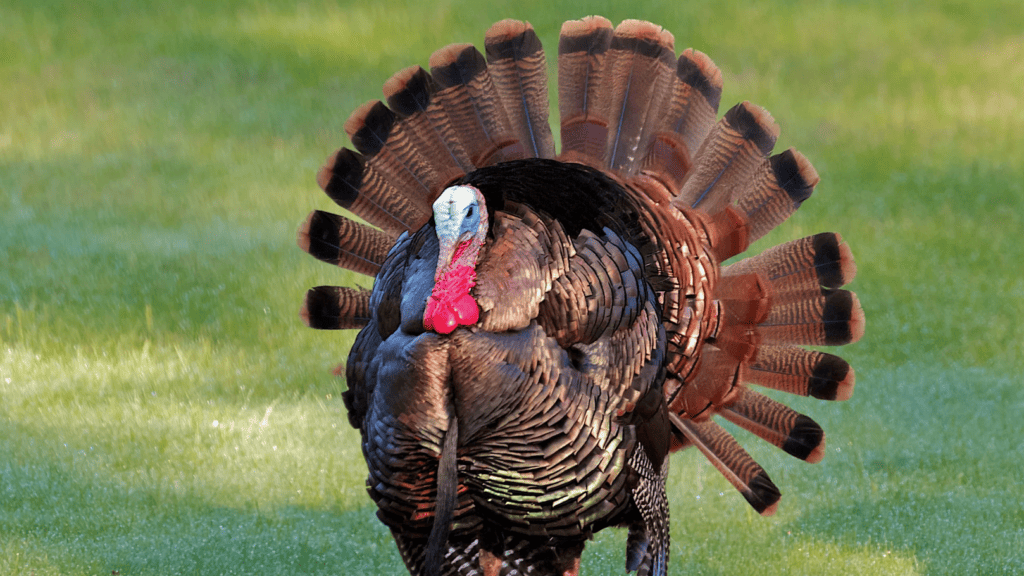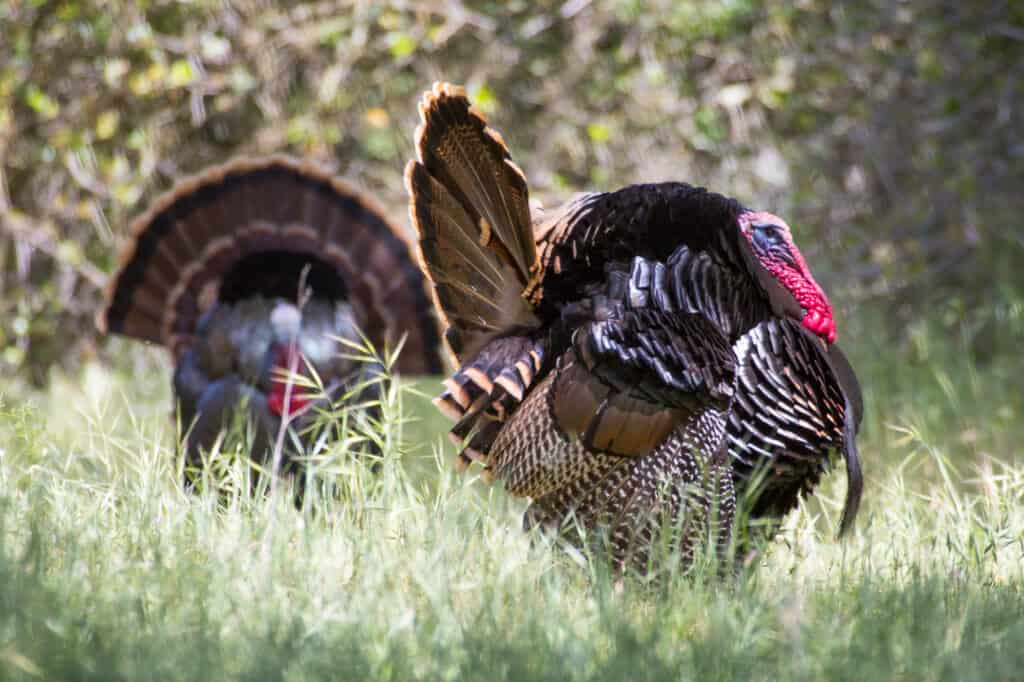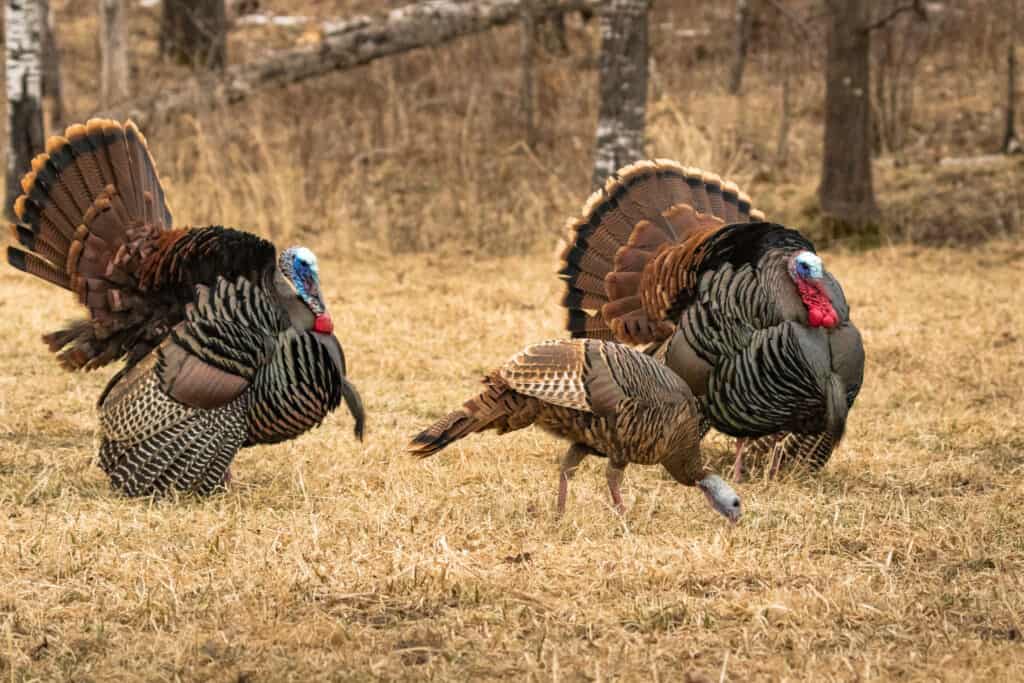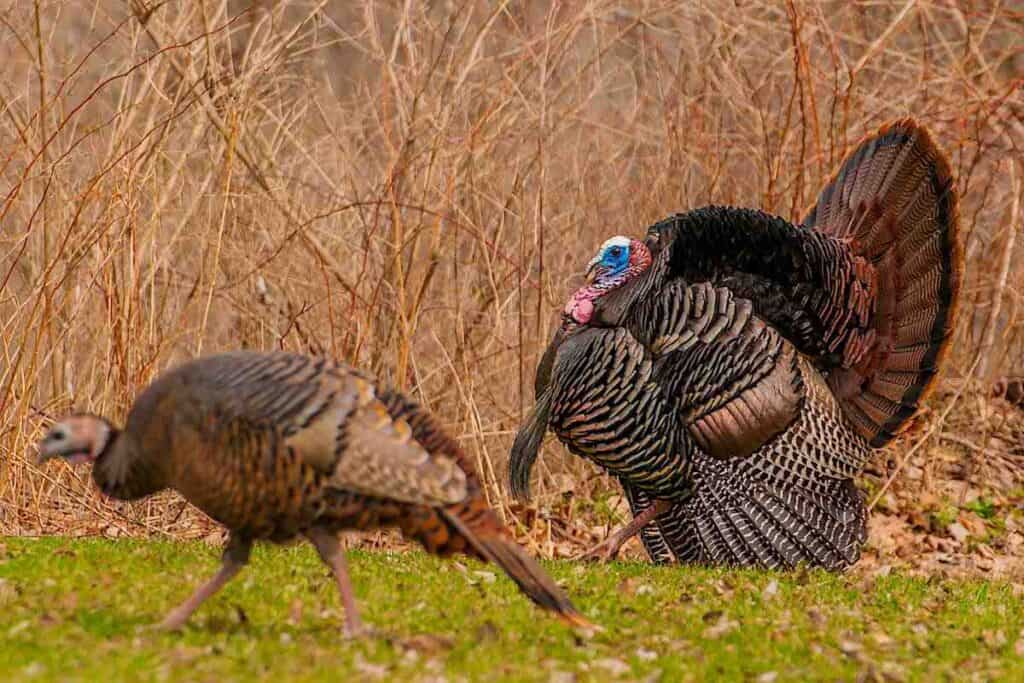Turkeys, like all other animals, have a vocabulary that they use to communicate with one another throughout the year. The calls they make vary depending on the season. Although spring is when we try to imitate these sounds to catch the attention of a tom looking for love, but that is often easier said than done. Turkeys can be some of the toughest animals to outsmart, and you’ll have to work for it.
Knowing the best turkey calls to use in the spring is the key to successfully calling in a gobbler. Each noise that a turkey makes has a specific meaning. Every one of them can be replicated using a variety of manufactured calls, but the physical call or a brand of call isn’t what we are going to focus on today. Whether you prefer a slate or box call, the type of call you make can have a big difference in the spring.
Today, I will explain the best calls to use during the season, the meaning of each call in the turkey language, and how you can successfully implement them into your calling strategy this spring. If you are new to turkey hunting, buckle up, knowing which calls to use is half the battle!

Springtime Turkey Talk
Springtime for wild turkeys is the breeding season. Many of the noises that you hear are directly related to a tom or jake searching for a hen or vice-versa. Sometimes the hen is out seeking a gobbler. This throws a twist into our plans as hunters. You can put in hard work trying to sweet talk a big longbeard and he’ll hang up trying to bring the hen (you) to him instead.
When setting up to call a gobbler there are several calls you will want to use, and know how to work them into your calling sequence to fool a tom into range. A basic yelp can get you a long way, but if you really want to get good at calling turkeys, you will need to add a few more tools to your belt.
For more on these sounds and for audio examples, you can check out my other article, “Wild Turkey Calls & Sounds, Plus Audio” right here.
Yelp
The yelp is the most used sound when calling turkeys. If there is one call to master this is it. It consists of a series of two-toned notes consisting of a high pitched front end dropping into a low and sometimes raspy back end. It is almost like an “alp” sound. Both hens and males will yelp, although a jake or tom yelp is noticeably different.
A yelp can be used softly as a tree call to let a gobbler know that there is a hen nearby. He may fly to you right off the roost. It can also be used as a kind of challenge call when made to mimic a jake. When modified through cadence, volume, and length it can mean a whole bunch of things. A yelp can be calling for another turkey to come, notifying other turkeys where it is located, or sometimes it just seems to be babbling.
If you want to see a little more about turkey roosts and how to find them, I wrote an entire article on it recently that you can see here.
A hen will use yelps to get the attention of gobblers in the area. A hen’s yelping is its way of saying “Hello, where are you?”, “I’m lonely”, “come find me“, “I’m here”. During the spring this is likely one of your go-to calls. You can use it when you think you are within earshot of a gobbler, and you can keep using it periodically to keep him interested. The yelp will make up the base or majority of your calling sequences.
Cluck
The cluck is one or more singular notes often produced individually from a cadence or in short calm cadences. This sound is used by turkeys to grab the attention of others in the area and communicate a calm and contented state of being. A turkey will cluck intermittently with both soft and loud vocalizations and pair it with any other calls.
The cluck is a basic call and is a must-know to produce other parts of turkey vocabulary. When using clucks to fool a gobbler, be mindful not to turn it into a putt (alarm call). I wouldn’t use this call all the time during the spring, but if you are talking with a gobbler and he suddenly goes quiet, give him some time, but if you can’t get a gobble back, a cluck might be the ticket.

Cutt
Cutting is a series of loud, short, and sharp notes that are faster than a cluck. They can be mixed in with yelps or individual from them but are always part of an ongoing cadence. Cutting is used by a hen in the spring when she is excited. The excited cutting is a great call to get a reaction or gobble from a tom in the area.
Remember, as turkey hunters we are in a sense calling turkeys backward, too much cutting may cause a tom to hang up and wait for you to go to him. If this happens the way to combat it is by going silent. A cutting hen that goes silent will likely cause a tom to come and investigate.
Because cutting can also be used for a hen to excite other hens, this can be a great way to drag a henned up gobbler in by pulling in his hens. He will likely walk along behind them. You can find toms hung up on hens fairly often during the spring, so keep this call in your back pocket if you can’t get a tom to come within range of your setup.
Purr
There are two types of purrs, one is a fighting purr which is made as an aggressive, territorial call used during a fight or preceding a fight with another turkey or animal. The fighting purr can seal the deal, especially when combined with a tom or jake decoy. It will make a dominant gobbler think there is a fight going on that he is not a part of, and he wants to be feared. An educated gobbler may not respond well to this call so you’ve gotta use your best judgment.
The other type of purr, and the most common, is a soft rolling sound that is made by turkeys when they are content moving about feeding in the leaves. It is often accompanied by soft clucks and yelps. This is a call that tells other turkeys that they are content. It puts the gobblers at ease. Mix this up with some scratching in the leaves and you can have some late season success with turkeys that are hesitant to close the distance.
Fly Down Cackle
The fly down cackle is heard during the morning when turkeys are pitching down from their roosts. This call tells other turkeys that they are headed down to the ground and helps to give the others locations of where the turkeys are. Often when you hear this sound, you estimate how far a turkey has flown from its roost by tracking the sound to where it seemed to stop.
This is an excellent call for the first thing in the morning, but timing is everything. The most productive way to use the fly down cackle is when you have a gobbler nearby. Give a fly down cackle before he pitches off the roost and at a realistic time. This can make you the first hen on his mind, and he may come to search you out first.
Gobble
The sound that is most often associated with turkeys is none other than the gobble. The thundering noise of a big longbeard gobbling through the trees is what turkey hunters lose sleep over. Although you may hear a gobble here or there throughout the year, spring time is definitely the peak for gobbling.
The main reason a male turkey gobbles is to let all the hens know where they are. Gobbling is also used to show dominance and willingness to breed. On the roost, a jake or tom may gobble to let every other turkey know they are awake, much like a rooster does in a hen house.
A gobble can be made by a hunter using a variety of calls, specifically a gobble tube. If you are skilled enough it is possible to produce this sound on a mouth call as well as with your natural voice, like the turkey calling legend Preston Pittman does.
Using a gobble is not always recommended especially on public land as you may call in other hunters that think you are a tom and put yourself in danger. Using a gobble call may also drive away younger birds that feel inferior, even if you would be happy taking them home.
It is not recommended in most situations but the correct use of a gobble call can change a hunt for the better. Gobbling to a hung up turkey can be the challenge an older gobbler needs to break and come in to fight for his “hen”.
Putt
A putt is a short and sharp note that is used as an alarm when turkeys feel they are in danger. This is a common call at all times of the year and may be all too common for spring turkey hunters. When you hear it as a turkey hunter it usually means you have been seen and the excitement you were feeling is over.
The only reason we see a put used in the field is to pull a turkey out of the strut to shoot. Even in this situation, there may be better options. Personally, I am not going to use the putt too much, if ever throughout the season.
The Sound of Silence Can Be The Perfect Call
There is nothing that gets your blood pumping quite like a big long beard firing up to a perfect sequence of yelps and cutts you aired with your call. Although, if your goal is to be frying up turkey nuggets for lunch this isn’t always the best tactic.
This is such an important aspect of calling that I wrote an entire article about it. I’ll cover the basics here, but check out “How Often Should You Call When Turkey Hunting” right here.
Even in the spring silence and leaf scratching is the most common noise a turkey will make. Most of the day they will be quiet. As hard as it might be to put that call down there are many times you should. Turkey hunters hate the sound of silence, but it may be the most productive sound to call in turkeys. I’m not saying go sit and wait like you are waiting for a deer to walk out into a food plot. Instead, use silence to drive a turkey crazy and pique his curiosity.
Remember, in nature, hens seek out toms. Continuously calling, no matter how good you sound may just cause an old longbeard to hang up and think he’s got you hooked to come to him. It’s at this time when going silent will drive him crazy enough to come searching for you. Before you know it he will be strutting at the end of your barrel.
So if you are getting a lot of action out of a tom, you don’t have to match him call for call. Playing hard to get can sometimes be the best thing to do. Now, you still have to keep him interested, so don’t get a single gobble and go silent forever. Get into a good spot as close as you can, and if he is fired up, let out a few yelps and let him come to you.

The Best Spring Turkey Calls to Know
Obviously, turkeys make many calls in the spring. If there is a list of the best calls to use when hunting turkeys it would be yelps, cutts, clucks, purrs, and silence. Something more important than being able to produce these sounds is knowing when to use them. Overcalling or calling at the wrong time is a mistake all turkey hunters make.
Calling too much may cause a wary tom to hang up as they wait for you to go to him. With these hung up turkeys the best plan is to drive them crazy by either going silent or if you are certain they cannot see you, move. Once a tom thinks his hen is getting away there is a good chance he will make a move to find you if he isn’t busy with another hen.
How Weather Affects Turkey Vocalization
So, here we go on to the age old question of what makes a turkey gobble. Yes, it is mainly a springtime vocalization of a male turkey used to entice hens to seek them out to breed. It can also be a sort of involuntary reaction, also known as a shock gobble, to a loud noise such as thunder, an owl, a crow or a slamming truck door. You may wonder, “Why is gobbling so prolific one day and suppressed the next?”
The answer to this is relatively unknown but the best guess is that gobbling is weather related. Like all animals, turkeys are affected by barometric pressure and weather. The National Wild Turkey Federation has spent time figuring this out and the data has concluded that barometric pressure and wind speed play the biggest role in the frequency of gobbling.
The data collected has shown that barometric pressure between 29.9 and 30.2 and wind speeds between 3-6 mph is when turkey vocalizations are at their highest, but when the barometer drops below 29.7 or the wind speeds exceed 12 mph that activity decreases substantially.
Battle Weather With Different Calls
During windy or rainy days, everything in the woods is loud and moving. It is not only difficult to hear a turkey vocalizing but it is also difficult for them to hear your calls. This is where loading your vest up with a variety of calls is helpful.
Different calls produce sounds in different ways. They can be grouped into two categories: friction calls and diaphragm calls. Friction calls are pot calls, box calls, and push button calls. Diaphragm calls, which are better known as mouth calls, use air blown over reeds of material to create noise.
When the woods are noisy, you may have better luck reaching out with a higher pitched call such as one made of crystal, aluminum, or glass instead of slate. Sometimes a larger, louder box call is the ticket. Play around with your calls in these situations, you will soon figure out which is the best for the weather condition. Just don’t try to blow too loud through a mouth call and end up making a sound that would only resemble a dying demon turkey.

Don’t throw the towel in just because it’s windy or rainy, instead experiment and focus more on location. Focus on the leeward sides of ridges or in open fields where a turkey has the advantage of eyesight where foliage isn’t blowing around. Just be careful and watch your surroundings, you are more likely to walk up on a quiet turkey during bad weather days. You don’t want to move around too quickly when you are having a rough time getting turkeys to call back just to jump the only turkey you have seen all day.
Closing Thoughts
There are several calls on the market, but only some callers can produce every sound in the turkey vocabulary on one call. Keep different types of calls in your vest and practice with all of them. You don’t need to be a champion level caller to kill a turkey.
Diaphragm calls are the most difficult to master, but being able to produce every call with minimum movement is the ideal way to fool a wise old tom. If you are not comfortable with a mouth call, the best call is the one you have the most practice with.
You don’t need to produce every springtime turkey sound with one call, but it is important to be able to produce yelps, cutts, clucks, and purrs. This can be done using a variety of calls and at multiple tones. Remember, once you get a tom’s attention silence is sometimes the best call of all.
Sister Post | 9 Tested & Proven Turkey Locator Calls
A sister post is another post that I have written that follows along with the same topic as the one you just read. After reading this article, you will probably like this next one even more! Here is a little teaser…
One of the biggest challenges of turkey hunting is finding turkeys. That’s where locator calls come in. Turkeys have a reflex which causes them to gobble at loud noises, which we call a shock gobble. We can use this to our advantage to find them…Keep Reading
1 | The Most Popular Locator Call: An ****** Call
The owl call is awesome for locating turkeys, especially before they come down off their roost and before they go back to their roost in the evening. You will never hear…Keep Reading
2 | Gobblers Will Surely Hear a Loud ******Call
The ******** call is my personal go-to locator call during the day. While the ******* call works great in the morning and evening, you do not hear many ******* during the day…Keep Reading
Thank you for reading my article! I hope you enjoyed it, and if you have any questions or feedback, please send me an email at [email protected]. If you want to learn more about me or Omega Outdoors, visit my About Page. Otherwise, I hope you have a great day, and check out some of my other articles while you’re here!

